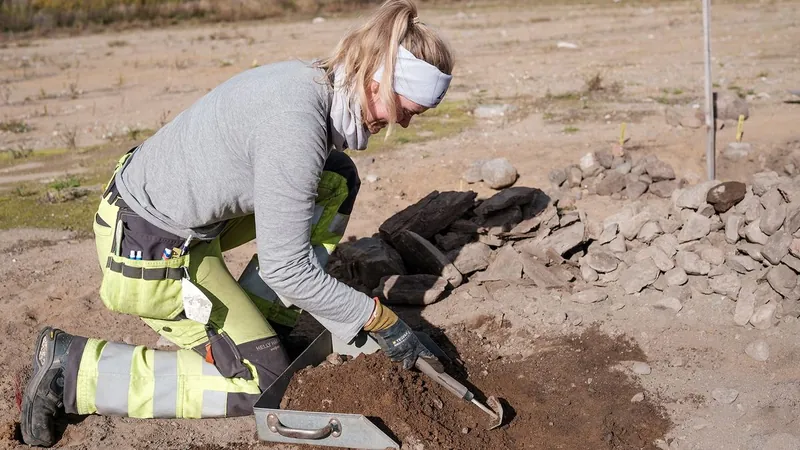
Archaeologists Discover Mysterious Knife in Iron Age Woman’s Grave—What Could It Mean?
2024-11-03
Author: Wei
Archaeological Discovery in Sweden
In a remarkable archaeological find, experts in Sweden have unearthed an ancient iron pocketknife embedded in the burial site of an Iron Age woman. This intriguing cemetery, which dates back between 500 B.C. and 400 A.D., consists of at least 50 burials, but none is as peculiar as this one.
Moa Gillberg, an archaeologist with Sweden's National Historical Museums, stated, "The people who buried the woman centuries ago stuck the knife into the grave; we don’t know why, but it is clear that it was meant for her." This enigmatic burial raises questions about the customs and beliefs of the society at that time.
Location and Historical Context
Located in the southern Swedish borough of Pryssgården, approximately 105 miles (169 kilometers) southwest of Stockholm, the cemetery's existence was hinted at by a late-17th-century text drafted by the Swedish priest Ericus Hemengius. He was responsible for documenting ancient cemeteries in his parish, yet it was uncertain whether any of the graves had survived into modern times.
Excavation Findings
During their recent excavations this spring, archaeologists from the National Historical Museums used metal detectors to discover jewelry and, as they dug further, they stumbled upon not only numerous graves but also remnants of ancient dwellings, a storehouse, and a well.
Common burial practices of the Iron Age involved cremating remains and placing them in shallow pits, yet some burials were marked by small, symmetrically arranged stones—a detail that suggests a ritualistic component to their death customs.
The Iron Age Woman's Grave
In the specific grave of the Iron Age woman, a thick layer of charred remains and bone fragments was uncovered. Gillberg explained, “When we dug down, we saw that they had put an iron folding knife directly into the ground.” Accompanying the knife was a small needle, pointing towards the woman's possible role in textile creation or repairs.
Significance of the Knife
The well-preserved knife may have served multiple purposes, including leather preparation, food preparation, or potentially even self-defense. Interestingly, there are known examples from the same period where knives and needles were found in women’s graves, particularly from the late Iron Age and early Viking Age (A.D. 793-1066) across southern Sweden, indicating a cultural connection.
Future Excavations
Archaeologists have plans for further exploration at the Pryssgården site. Although they initially mistook one notable pit for a grave, they later identified it as a large posthole, suggesting the presence of a wooden structure that may have been utilized in burial rites.
Gillberg hinted at the possibility of uncovering more such pits, saying, “Sometimes you build monuments on the funeral pyre, so maybe this was one of those.” As this excavation continues, the mysteries surrounding the knife and its significance in the burial remain unsolved, offering a tantalizing glimpse into the spiritual beliefs and customs of an ancient society. What other secrets lie beneath the surface waiting to be uncovered? Stay tuned for what future excavations might reveal!



 Brasil (PT)
Brasil (PT)
 Canada (EN)
Canada (EN)
 Chile (ES)
Chile (ES)
 Česko (CS)
Česko (CS)
 대한민국 (KO)
대한민국 (KO)
 España (ES)
España (ES)
 France (FR)
France (FR)
 Hong Kong (EN)
Hong Kong (EN)
 Italia (IT)
Italia (IT)
 日本 (JA)
日本 (JA)
 Magyarország (HU)
Magyarország (HU)
 Norge (NO)
Norge (NO)
 Polska (PL)
Polska (PL)
 Schweiz (DE)
Schweiz (DE)
 Singapore (EN)
Singapore (EN)
 Sverige (SV)
Sverige (SV)
 Suomi (FI)
Suomi (FI)
 Türkiye (TR)
Türkiye (TR)
 الإمارات العربية المتحدة (AR)
الإمارات العربية المتحدة (AR)